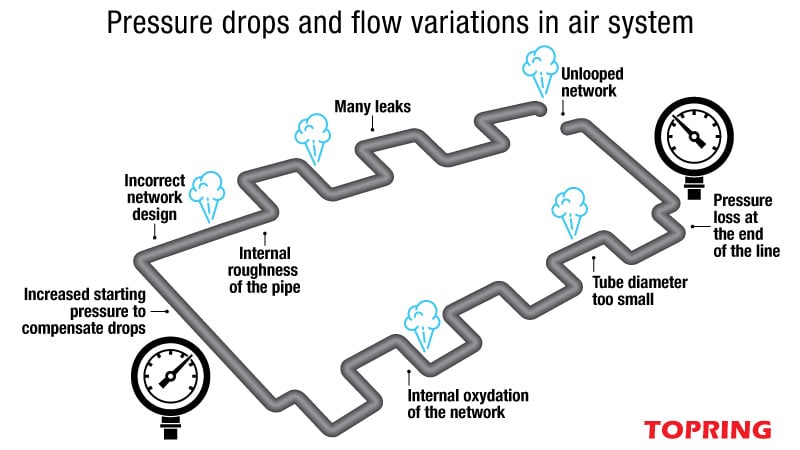When we talk about "compressed air" with workshop managers, technical directors or maintenance managers, we very often hear the same thought: "At the end of the network we couldn't keep enough pressure (PSI) to work, so we increased the pressure of the compressed air." That's a mistake, it doesn't work! But why?...
Air compression
Compressed air results from a mechanical increase in the air pressure at the start: ambient air or atmospheric pressure. The machine, the compressor, will concentrate as many volumes of air as necessary in only one of these volumes. The more volumes are concentrated, the stronger the pressure. This pressurized air, called compressed air, is then propelled into a pipe and will be available throughout the air network. Different compression processes exist on the market (pistons, screws etc.), but the basic principle always remains the same: the more pressure is needed, the more air will have to be accumulated in a single volume.
The 5 causes of pressure drop
Once compressed, the air is sent into the pipe and thus routed to the fitting where the pneumatic tool will be connected. Ideally, everything is fine, but reality often imposes its constraints... If we take the time to follow the thread of this pipe, we will very quickly see the defects. To fully understand the phenomenon, we will follow our channeling step by step and identify the problems!
1. Leaks
Leaks, easily spotted (at least for the most important) thanks to their characteristic whistling (the "pssss" that can be heard everywhere). Who says leaks, obviously says loss of air and of course loss of pressure. A bit like a flat tire on our car. The air escapes and the pressure drops... The tire is deflating!
2. Air network design
The design of the network also falls very largely into the list of problems. Often in the workshop, the pipe draws very complicated contours that have followed the history of the company (elbows, tees etc.). The accumulation of all these obstacles generates strong pressure drops. Just like the traffic of a winding mountain road compared to that of a straight highway...
3. The section of pipe carrying the air
Unfortunately, in many workshops the diameter of the pipes has never been taken into consideration, going from a possible good original diameter to a very small section (for example in a first extension) and then another diameter etc. Each narrowing could be compared to a tunnel that quickly becomes a big black spot on a busy road.
4. The material of the pipes
Beware of the nature of the pipe because we could often see steel tubes that were of a correct outer diameter, but whose inner walls were gnawed or swollen by rust! The friction and internal turbulence of the airflow generate very large pressure drops! Always prefer a pipe made of smooth and corrosion-resistant material (aluminum for example). We always drive more slowly, and not as well, on a forest road than on a highway!
5. Network closure
Or rather the "non" closure of the network. When the pipe is a "one-way" line, the accumulation of successive problems collected throughout the journey will cause an increasing pressure drop along this line. The closure of the network could be compared to the beltway of a city that makes it possible to fluidify road traffic in both directions around the city. Each exit ramp corresponding to an air descent.

• An unlooped network generates a longer journey for the air, thus increased friction and less reactivity;
• Each complication (elbow, tee etc.) causes a pressure drop and a risk of leakage;
• A rough and oxidizable material causes strong turbulence in the pipe;
• An undersized inner diameter significantly reduces the passage of air;
• The slightest leak is a loss of flow and pressure. The cost of each leak is always very high.
The right solution to limit pressure drops
It is said: there is no problem without a solution! And here, it is!
1) The compressor can sometimes be the cause of the problem (but this is rare). An under-sizing of the machine will certainly lead to a flow rate and/or pressure that are too low. This may be the result of a bad choice at the beginning or a demand for air that has increased over time. In this case it will be necessary to consider a change for a machine better suited to current needs.
2) The air network is by far the most common reason for this situation. A new line, well designed in terms of network (a loop with straight lines), well sized in terms of tube diameter, and made of a smooth and corrosion-resistant material, will ensure perfect air circulation, without pressure drop. Such a network guarantees constant pressure and flow throughout the system, from the closest points to the furthest from the compressor! So that's a real solution to this real problem.
In conclusion
If you notice a pressure drop at the end of the air network, never increase the pressure at the compressor, instead perform a complete check of your air line. You will quickly find the defects! This is where the solution lies! Contact our specialists, they will bring you a guaranteed result that will most certainly cost you much less than doing nothing!!!

